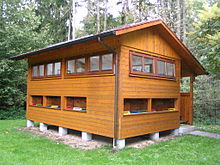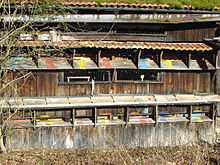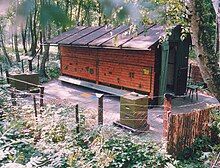Apiary
The apiary ( Apiarium ) is a building in which beekeepers several hives up and beekeeping equipment can be stored. Most of the houses are made of wood in a bee-friendly manner , and more rarely in masonry . Up until their decline in the 1970s, bee houses were widespread, especially in German-speaking countries , while beekeepers in the rest of the world have always kept their bees outdoors in the magazine mode .
history
Apiaries did not appear until the 19th century, when the need arose to protect the newly developed wooden beehives from the weather. In contrast to the smaller apiary and the beehive , an apiary is a larger and more permanent facility. Such houses were not required in historical beekeeping. In the mediaeval Zeidlerei , bees were kept in hollow tree trunks in the forest. Later, the beehives cut out of the tree were set up as so-called log hives near the apartments. In the basket beekeeping with straw baskets as housing, which was operated until the second half of the 19th century, the apiary was under a "shower", which in the heather beekeeping was called the bee fence . With the invention of the frame as a movable honeycomb in 1853 by Baron August Freiherr von Berlepsch (1815–1877), a wooden beehive , the so-called rear treatment hive, spread . This bee housing was not weatherproof and required a rainproof installation. Many beekeepers in German-speaking countries then built beehives on their property or in the open countryside, mostly near the forest. The beehives could be stacked on two or three levels, so that the space of an apiary could be optimally used.
advantages
The solid building provides very good weather protection for the beehives, which are still made of wood today. Many devices and parts required for processing, such as magazine hives , honeycombs , honey harvesters ( honey extractors ) can be accommodated in the house. The beekeeper can work on or control the colonies even in adverse weather conditions (wind, rain). It was not uncommon for the honey to be hurled in a separate area and even all work for breeding queens was possible. This eliminated the need for transport work and other space that would otherwise be required. In addition, there is protection against theft and a certain protection against mischief and vandalism .
disadvantage
Setting up an apiary requires a much higher investment for the beekeeper than setting it up outdoors. A building permit is almost always required. In urban areas, the building usually exceeds the room size that does not require a building permit; in the outlying areas, a permit is mandatory in order to protect against urban sprawl . In the international line-up in the apiary of the beekeeper is not very mobile and lets the people are mostly local. In poor nectar collecting possibilities thereby the honey harvest will be lower than if rich source of nectar is migrates be. The individual bees can also easily disappear into other bee colonies. In summer, high temperatures make it difficult for beekeepers to work in the apiary, which is due to the sun's rays and the bees' body heat. The spatial confinement and the relative darkness also prove to be unfavorable.
Decline
With the increased emergence of magazine loot in German-speaking countries in the 1970s, beehives became superfluous. These beehives were cheaper and promised higher honey harvests because they can be set up outdoors and operated as a traveling apiary. Many beekeepers therefore exchanged their beehives for the modern magazines. The GDR was an exception , where until the German reunification in 1990 there were mostly apiaries and widespread beehives , with which hikes were possible without much effort.
Even before 1970 , honey bees were mostly kept in magazines around the world . This is due to the fact that beekeeping is a profit-oriented branch of business in other countries. The warmer climate that prevails in many countries where beekeeping has traditionally been heavily represented ( Spain , southern France and others) also plays a role . German beekeeping, on the other hand, has been pursued as a hobby by enthusiastic and inventive hobby beekeepers for the past 100 years, whereby the yield is not the primary goal.
Apiary
A simpler form of the apiary is the apiary or beehive . This is a much smaller, permanently set up free area that only protects the hives from the elements. Its advantage is that compared to the immobile apiary, it can usually be set up without a building permit and can be removed again at short notice without major effort.
Fixed apiary in the Glentleiten open-air museum , built at the beginning of the 20th century
See also
literature
- Suggestions for building apiaries. Leaflets for beekeeping practice. Leaflet T. Deutscher Imkerbund eV, Bonn 1981.





